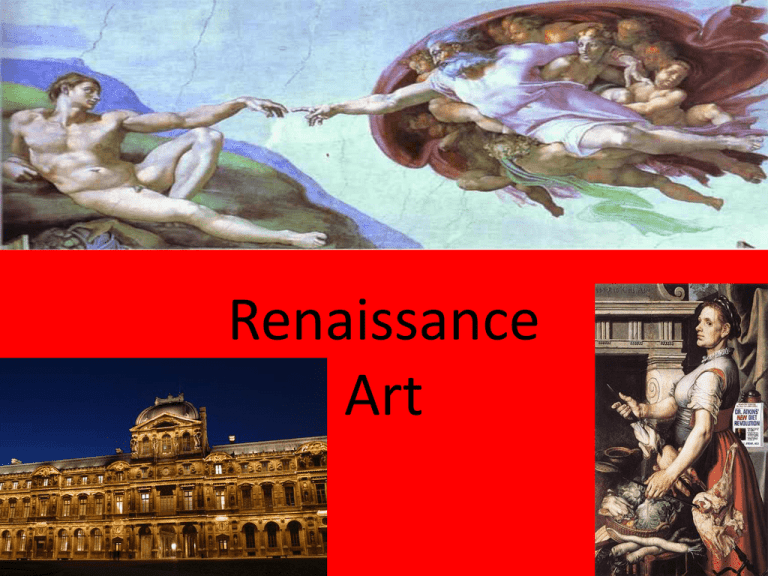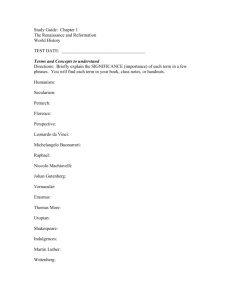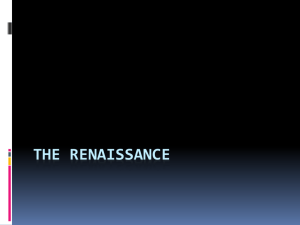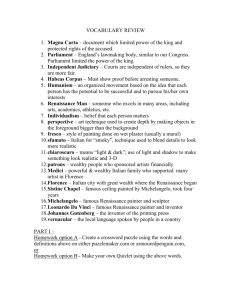Renaissance Art2
advertisement

Renaissance Art 1 Characteristics of the Renaissance • Humanism – focus on worth of man, especially rationality, not just because it is part of the church • Individualism – man has right to, and ought to be self reliant • Questioning Attitude / Critical thinking • Interest in Secular, or non-religious, worldly matters • Rise of the middle class • Great achievements in the arts 2 Medieval Art • Artists depicted subjects in an unrealistic twodimensional style to indicate the importance of the soul over the body (religious theme). • Some of the great art work was in the stain glass windows, but again, two-dimensional. 3 Renaissance Art 4 Characteristics of Renaissance Art • • • • • • • • Three Dimensional (3-D) Realistic & Lifelike Linear Perspective: Vanishing point Influenced by Greco-Roman culture; its forms and its themes (i.e. beauty of the human body) New mediums: Oil on canvas And old: Frescos Sculpture in the Round / in Relief The importance of religion in art 5 Leonardo Da Vinci • The Last Supper 6 Leonardo Da Vinci • Mona Lisa 7 Michelangelo • Moses 8 Michelangelo • The Last Judgment 9 Raphael • Madonnas 10 Albretch Durer • Adoration of the Magi 11 Renaissance Architecture 12 St. Peter’s Cathedral in the Vatican • Michelangelo (also painted the ceiling of the Sistine Chapel and Moses) 13 Dome of the Cathedral of Florence • Brunelleschi 14 The Renaissance Moves North • Because of the plague, it was not until 1450 that northern Europe enjoyed the economic growth that helped support the Renaissance in Italy. • Northern artists and writers imitated Italian styles while adding new methods and ideas of their own. • As a result of the printing press, books became more available and people became more literate. 15 Renaissance Writers • Began to use the vernacular instead of classical Latin. –(vernacular = the native language) 16 Humanism • Humanism is the idea that is focused on human achievements and potential rather than religious themes. • Focused on the man and his world. (The importance of man) • Concentrated on everyday human problems and relationships. • Humanists focus on reality and the world around them (How man relates, pleasure, passion) rather than morality.) 17 Humanism • The secular nature of humanism, as well as it’s questioning attitude, often brought it into conflict with the traditional teachings of the Catholic Church and Medieval thinking. • It revolves around the study of the Liberal Arts: Grammar and Rhetoric, Poetry, History, and Ethics. 18 Petrarch • Considered the Father of Humanism. • Believed that God had given man his intellect and potential to be used to the fullest. • Wrote poetry in Italian and enumerable works in Latin on different subjects, but is best known for his Letters, which fill two volumes. 19 William Shakespeare Hamlet Taming of the Shrew A Midsummer’s Night Dream Romeo & Juliet The Histories The Comedies The Tragedies 20 Shakespeare • The best known Renaissance writer was William Shakespeare. • Between 1590 and 1613 he wrote 37 plays that are still performed around the world. 21 Dante • The Divine Comedy • Story written in the vernacular (Italian) which tells the story of a man’s journey through heaven and hell. 22 Geoffrey Chaucer Whan that Aprille, with hise shoures soote, The droghte of March hath perced to the roote • The Canterbury Tales • Series of stories depicting the lives of whole social spectrum on a pilgrimage to the shrine of Beckett at the Canterbury Cathedral in England 23 Machiavelli • The Prince – First work of political science, instruction manual for the Prince to do what is necessary to stay in power and stability. 24 Machiavelli • Machiavelli was a political philosopher. • The Prince advised kings how to rule. • In Machiavelli way of thinking, there are no means in which the end does not justify. (The end justifies the means.) 25 Thomas More • Utopia, a work of fiction, tells the story of a land that is almost perfect in every way and serves as an example of what the world should be. More is known as the “Man for all Seasons” because of his versatility. 26 The Printing Revolution • In 1456, Johann Gutenberg printed the Bible using movable metal type on a machine called a printing press. • Printed books became cheap and easier to produce than hand copies. • Now, readers gained access to broad range of knowledge. (Medicine to Religion) • The printing press would greatly contribute to the Protestant Reformation. 27 The Effects of the Renaissance • The Renaissance belief in the dignity of the individual played a key role in the gradual rise of democratic ideas. • Led to the Scientific Revolution • Led to the Age of Exploration





